|
| Links | Andrena hippotes – A fairly common vernal mining bee associated with forests. Females are noted for their red legs (tibia and tarsi), broader facial fovea, mesepisternum with large pits, sparsely pitted mesoscutum, and T1 with pits separated by 2-3 pit diameters and thus appearing sparsely pitted.
- Hosts
|
80x5 -
240x3 -
240x4 -
320x1 -
320x2 -
320x3 -
640x1 -
640x2
Set display option above.
Click on
images to enlarge. |
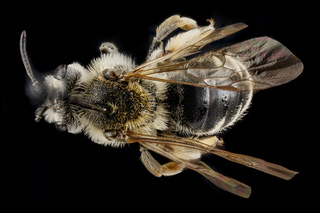
© Copyright source/photographer
· 9
Andrena hippotes, female, back |
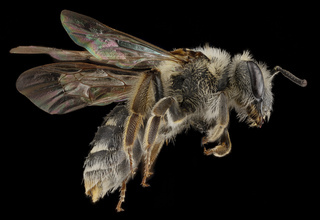
© Copyright source/photographer
· 9
Andrena hippotes, female, side |
|
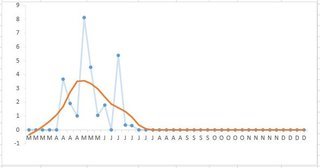
© Copyright source/photographer
· 9
Andrena hippotes, Mid-Atlantic Phenology |
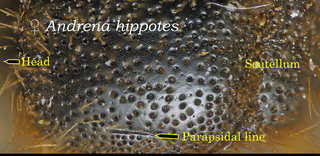
David Cappaert · 9
Andrena hippotes, thorax, scutum, hippotes |
|
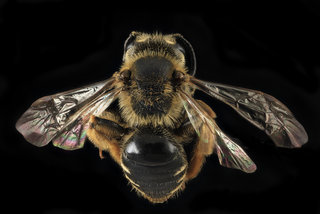
© Copyright source/photographer
· 7
Andrena hippotes, Female, Back, Maryland |
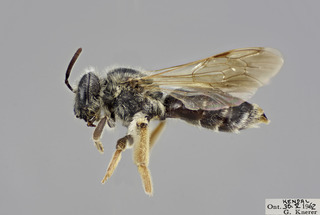
© Copyright Laurence Packer 2014
· 7
Andrena hippotes FEM CFP comp |
|
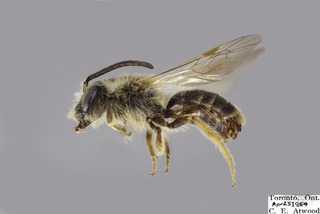
© Copyright Laurence Packer 2014
· 7
Andrena hippotes MALE CFP |
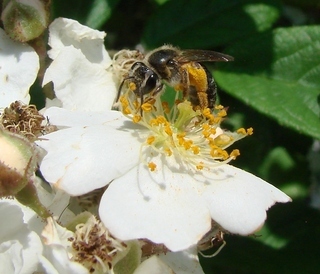
© Copyright John Ascher, 2006-2014
· 6
Andrena hippotes |
|
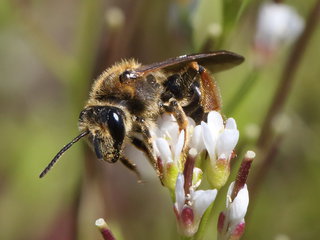
Michael Veit · 6
Andrena hippotes, f on Arabis -- |
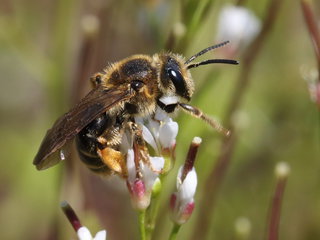
Michael Veit · 6
Andrena hippotes, f on Arabis -- |
|
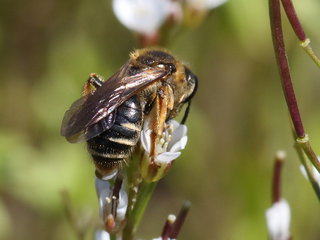
Michael Veit · 6
Andrena hippotes, f on Arabis -- |
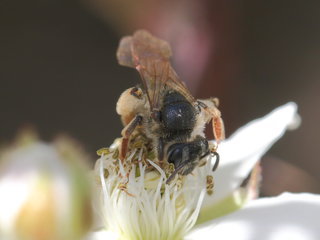
© Copyright Micheal Veit 2010
· 6
Andrena hippotes, f on Rubus -- |
|
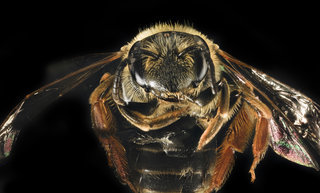
© Copyright source/photographer
· 5
Andrena hippotes, F, Face |
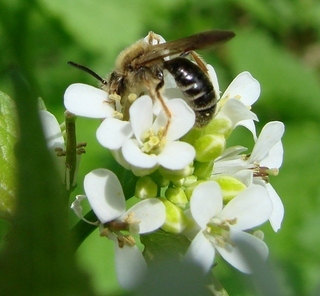
© Copyright John Ascher, 2006-2014
· 5
Andrena hippotes, Hippotes Andrena mining bee |
|
Overview |
Reprinted with permission of the American Entomological Society from:
LaBerge, W. E. 1973. A revision of the bees of the genus Andrena of the Western Hemisphere. Part VI. Subgenus Trachandrena. Transactions of the American Entomological Society 99: 235-371.
Please report text errors to: leah at discoverlife dot org.
This species is readily recognized in both sexes by the red tarsi and hind tibiae, the sparsely punctate basal area of tergum 1 and the relatively sparsely punctate mesoscutum. The female is further distinguished by the broad facial foveae, the relatively long apical area of tergum 2 and the smoothly curved or straight posterior hind tibial spur as in forbesii. The male is like forbesii in having an emarginate sternum 6, a smoothly curved or straight hind tibial spur and a relatively short first flagellar segment.
FEMALE. MEASUREMENTS AND RATIOS. N = 20; length, 8-11 mm; width, 2.5-3.5 mm; wing length, M = 3.77 0.166 mm; FL/FW, M = 1.05 0.004; FOVL/FOVW, M = 3.22 0.042.
INTEGUMENTAL COLOR. Black except as follows: mandible with apical third rufescent; flagellar segments 3-10 dark reddish-brown below; tegulae moderately translucent, brown; wing membranes hyaline, slightly infumate, veins reddish-brown to red; distitarsi dark red to bright orange; middle and hind basitarsi and occasionally fore basitarsi dark red to bright orange; hind tibiae red to orange.
STRUCTURE. Antennal scape length equal to first four flagellar segments or slightly shorter; flagellar segments as in sigmundi but segment 2 often slightly shorter than 3. Eyes each about three and one-half times as long as broad, inner margins converging slightly toward mandibles. Malar space, mandible and galeae as in sigmundi. Maxillary palpus as in sigmundi but segmental ratio about as 0.9:1.0:0.8:0.7:0.7:0.6. Labial palpus as in sigmundi but ratio about as 1.0:0.5:0.5:0.4. Labrum as in sigmundi but apical part with transverse sulcus weak, often crossed by one to three weak cristae, surface punctate and dull. Clypeus as in sigmundi but without median impunctate line or this represented by a small shiny subapical boss occasionally with a short line extending basad less than half length of clypeus. Supraclypeal area, genal area and vertex as in sigmundi. Face above antennae with small punctures separated by half a puncture width or slightly more, surface moderately dulled by fine shagreening, without rugulae or these restricted to lateral areas near foveae. Facial fovea relatively short, lower portion broad, at level of antennal fossae at least half as wide as upper portion, evenly tapered from broad upper to lower portion.
Pronotum as in sigmundi. Mesoscutum with large round deep punctures, between parapsidal lines and posteromedially separated mostly by one to three puncture widths or more, anteriorly and laterally separated by half to one puncture width, surface usually dull or moderately dull, reticularly shagreened. Scutellum similar but punctures usually coarser and surface often shinier. Metanotum as in sigmundi. Propodeum with dorsal enclosure with several coarse longitudinal rugae but these usually irregular and anastomizing especially basally; dorsolateral and posterior surfaces moderately coarsely punctatorugose; surfaces dulled by fine tessellation; lateral surface with coarse, irregular, short, rugae, moderately shiny, tessellate. Mesepisternum as in sigmundi. Fore femur with base round in outline. Posterior hind tibial spur straight or smoothly curved, not recurved in outer third as in sigmundi. Wing venation as in sigmundi.
Metasomal tergum 1 with basal area punctures sparse, usually separated by two to four or more puncture widths except at extreme sides, rarely more crowded; apical area punctures small, separated mostly by one to two puncture widths at least medially, with apical margin impunctate (one-third of apical area); surfaces shiny, weakly or not at all shagreened. Tergum 2 with apical area distinctly longer than basal area (about as 5:3); basal area punctures separated by half to one puncture width except sparse in narrow zone just basad of apical area; apical area punctures usually sparser than in basal area, medially separated mostly by one puncture width or more, with narrow impunctate apical rim (one-fourth of apical area); surface shiny, with weak reticular shagreening especially basally and laterally. Terga 3 and 4 similar to 2 but punctures progressively sparser and shagreening denser. Pygidial plate V-shaped with well-rounded apex and sharply pointed, internal, raised triangular area. Sterna 2-5 as in sigmundi.
VESTITURE. Generally white to pale ochraceous, somewhat darker on vertex and thoracic dorsum. Terga 5 and 6 and legs without brown hairs. Terga 2-4 with white apical fasciae reduced to small lateral patches, each less than one-third width of tergum (often absent).
MALE. MEASUREMENTS AND RATIOS. N = 20; length, 7-10 mm; width, 2-3 mm; wing length, M = 3.29 0,140 mm; FL/FW, M = 1.14 0.005; FS1/FS2, M = 0.69 0.014.
INTEGUMENTAL COLOR. Black with same exceptions as in female but flagellar segments 2-11 dark brown to reddish-brown below, terga 1-5 often with extreme apical margin hyaline or moderately infumate and hind tibia occasionally dark brown except red or orange apex.
STRUCTURE. Antennae in repose reaching propodeum; scape length equal to first two flagellar segments or slightly more; flagellar segment 1 much shorter than segment 2 and quadrate or only slightly longer than broad; segments 2-11 one and one-third to one and one-half times as long as broad. Eyes each slightly less than three and one-half times as long as broad, inner margins converging towards mandibles. Malar space, mandible and galea as in female. Maxillary palpus as in female but segmental ratio about as 1.0:0.9:0.8:0.8:0.8:0.8. Labial palpus as in female but segmental ratio about as 1.0:0.5:0.5:0.5. Labrum as in sigmundi. Clypeus as in female but punctures smaller and more crowded and longitudinal impunctate median line occasionally present but never complete, at most half or slightly more as long as median clypeal length. Supraclypeal area, genal area and vertex as in female. Face above antennae as in female but punctures more crowded and surface dull, reticularly shagreened.
Pronotum as in female but punctures sparse and surface opaque. Mesoscutum and scutellum as in female but punctures usually slightly more crowded and smaller, especially peripherally. Metanotum as in female. Propodeum as in female but lateral surfaces more regularly punctatorugose, surface dulled by fine dense shagreening. Posterior hind tibial spur and wing venation as in female.
Metasomal tergum 1 with basal area punctures as in female but often more crowded (separated by two to three puncture widths), rather variable; apical area as in female but punctures smaller. Tergum 2 as in female but apical area shorter, equal to about two-thirds length of basal area medially. Terga 3-5 similar to 2 but punctures progressively sparser. Sterna 2-5 as in sigmundi. Sternum 6 apically with a deep V-shaped notch (much as in forbesii). Terminalia as in sigmundi; see figures 36-38; sternum 7 (Figs. 36-37) often without apical emargination.
VESTITURE. Generally pale ochraceous but somewhat darker on vertex and thoracic dorsum. Metasomal terga without brown hairs; terga 2-5 usually without apical pale fasciae but rarely small lateral patches of white pubescence present.
REMARKS. An occasional hybrid specimen appears between A. hippotes and A. forbesii, especially in localities west of the Mississippi River. The name lincolni was given to what appears to be a hybrid female from Lincoln, Nebraska. These hybrids include less than 10% of the specimens from the western parts of the ranges of the two species and only a rare specimen from more eastern populations. They can be recognized because they appear sculptured as in A. forbesii but with hippotes-like coloration and broadened facial foveae. The hybrid males, if they exist, cannot be separated from somewhat atypical forbesii specimens.
Reprinted with permission from: Mitchell, T.B. 1960. Bees of the Eastern United States. North Carolina Agricultural Experiment Station Technical Bulletin No. 141.
FEMALE. Length 8 mm.; facial foveae broad above, occupying most of space between eyes and ocelli, constricted below to about half that width, covered with whitish tomentum; space between margin of vertex and lateral ocelli subequal to their diameter; cheeks subequal to eyes in width, rounded posteriorly, rather dull, very closely and finely punctate, punctures becoming somewhat more sparse on vertex laterally above eyes; malar space very short; clypeus broadly convex, projecting somewhat less than one-half below suborbital line, closely, deeply and rather finely punctate, punctures almost crowded, somewhat shining between punctures; process of labrum short and quite broad, apex obscurely and broadly truncate; pubescence of head, thorax and basal portions of legs whitish, becoming ochraceous on the more apical parts of legs; punctures of scutum coarse, deep, well separated anteriorly, becoming rather sparse posteriorly, those on scutellum about equally coarse, well separated but not sparse, surface somewhat shining; pleura finely rugose; dorsal area of propodeum oblique, triangle rather coarsely and regularly striate; propodeal corbicula short, poorly developed, whitish, without an anterior fringe; trochanteral floccus short and poorly developed, whitish; hind tibiae rather slender, slightly broadened apically, but apex not twice the width of basitarsi, bright ferruginous, scopa rather dense, entirely pale ochraceous; front basitarsi narrower than their tibiae, mid basitarsi bright ferruginous, nearly equaling their tibiae in width, hind basitarsi also bright ferruginous; 2nd submarginal cell much shorter than 3rd, receiving 1st recurrent near apex; abdominal terga somewhat shining, finely but deeply and distinctly punctate, punctures rather close in general. becoming almost crowded laterally, apical impressed areas shallow but quite broad, occupying medially about half length of discs, more finely and sparsely punctate than the basal portions of discs, discal pubescence extremely sparse and obscure, evident laterally, where the hairs are short, erect, whitish, terga 2-4 with white, apical fasciae evident laterally, tergum 5 with a golden-brownish, apical fimbria.
MALE. Length 7 mm.; face slightly longer than broad; clypeus convex, projecting nearly one-half below suborbital line, dull, densely and rather coarsely punctate beneath dense and rather short pubescence; space between margin of vertex and lateral ocelli subequal to their diameter; cheeks subequal to eyes in width, rounded posteriorly, dull, closely and finely punctate; malar space very short; basal segment of flagellum not much longer than breadth at apex, distinctly shorter than 2nd and following segments; process of labrum short, rather broad, apex somewhat narrowed, slightly emarginate; mandibles rather short, with a distinct, inner, subapical tooth, overlapping about one-fourth, pubescence of head, thorax and legs entirely brownish-ochraceous; punctures of scutum deep, distinct, rather close and coarse anteriorly, nearly as close posteriorly, those on scutellum slightly more coarse but quite close, surface somewhat shining; pleura rather coarsely rugose; dorsal area of propodeum oblique, triangle rather irregularly striate; all basitarsi slender and elongate, considerably narrower than their respective tibiae, ferruginous, as also the hind tibiae; 2nd submarginal cell considerably shorter than 3rd, receiving 1st recurrent about one-third from apex; abdominal terga somewhat shining, punctures fine, rather deep and distinct, quite close, apical impressed areas much more obscurely punctate, rather dull, shallow, occupying medially about one-third length of discs, becoming obscurely reddish-hyaline along rims, discal pubescence extremely short, thin, erect, entirely pale, terga 2-4 with pale ochraceous apical fasciae, those on 2 and 3 more or less widely interrupted medially; apical portion of sternum 8 very narrow and elongate, with a quite marked subapical constriction, apex rather broadly truncate, clothed beneath with rather long, pale pubescence; penis valves slender apically, slightly broadened basally, deeply excavated laterally, gonocoxites quite abruptly and broadly dilated apically to form subtriangular lobes which are markedly concave on the dorsal surface, gonocoxal lobes strongly produced, slender, acute, attaining the apical lobes.
DISTRIBUTION. Transcanadian and the Northern United States, in the East, south to Georgia; April to June.
FLOWER RECORDS. Aronia, Ceanothus, Ligustrum, Malus, Prunus, Pyracantha, Rubus, Salix, Spiraea and Viburnum. Also recorded by Robertson (1929) on Amelanchier, Cornus, Crataegus, Pastinaca, Ptelea, Sassafras and Zanthoxylum. Brittain and Newton (1934) record this species on Brassica and Kalmia.
Described using the synonymous name: Andrena arenakensis
FEMALE. Length 10 mm.; face slightly longer than distance between eyes above; eyes subparallel; foveae much narrowed below, but constriction not very abrupt, this area slightly removed from margin of eye; vertex narrow, lateral ocelli separated from its hind margin by about their own diameter; cheeks slightly broader than eyes; clypeus protruding about one-third below suborbital line, somewhat shining between deep, distinct, close and rather coarse, uniformly distributed punctures; face below ocelli somewhat shining, with fine and close but quite deep and distinct punctures, these becoming somewhat more coarse and rather close but more obscure and indefinite on vertex, those on cheeks very fine and uniformly close; malar space hardly evident; process of labrum very broad, subtriangular, with truncate apex, median length not much more than one-third basal width; basal segment of flagellum considerably shorter than 2nd and 3rd combined, median segments with length and breadth about equal; pubescence of head and thorax entirely pale, slightly yellowish, rather dense around antennae, at sides of face and on cheeks, but rather thin on thorax; scutum and scutellum shining between deep and distinct punctures, these rather close on scutum anteriorly, becoming quite sparse posteriorly, and sparse on scutellum; pleura dull, rather coarsely rugosopunctate; dorsal area of propodeum reticulate rather than striate, poorly defined, lateral areas reticulate; propodeal corbicula rather well developed but short, with a few inner hairs but no anterior fringe; trochanteral floccus rather short and thin; hind tibiae in part and all of tarsi ferruginous, other leg segments dark, pubescence entirely pale yellow, basitarsi quite slender, tibial scopa of rather elongate hairs, hind tibia slightly broadened apically, spurs pale testaceous; wings pale fuliginous, veins more testaceous, stigma somewhat brownish-testaceous; tegulae dark anteriorly, becoming yellowish-hyaline posteriorly and along outer rims; abdominal terga shining, finely and rather evenly punctate, segments 2-4 impressed for slightly less than half their median length, impressed area punctate about as basal areas, apical fasciae evident only toward extreme sides on segments 3 and 4, apical fimbria more yellowish.
TYPE - Holotype: Female, Arenak Co., Michigan, May 30, 1951 (R. R. Dreisbach). [Dreisbach]. This specimen is stylopized but does not appear to have been much modified so far as the secondary sex characters are concerned.
|
|
|
Identification | |
Extracted from Joel Gardner. "The mining bees of Minnesota (unpublished manuscript)" Andrena hippotes is the only Minnesota Trachandrena which can have orange hind legs. Care should be taken, however, to distinguish it from Andrena (Scrapteropsis) imitatrix, which can also have orange hind legs.
Extracted from: Charles, R. (1895). Notes on bees, with Descriptions of New Species. Transactions of the American Entomological Society Vol. 22, No. 2. pp. 115-128.
♀- Black, the middle tarsi and hind tibia and tarsi red; clypeus closely, strongly and evenly punctured; basal process of labrum
short, broad, emarginate; third joint of flagellum shorter than next two together, disc of mesothorax strongly, not closely punctured, with thin, pale pubescence; enclosure of metathorax strongly rugose, poorly defined laterally, terminating in a sharp edge at truncation. Wings nearly hyaline, nervures and stigma testaceous, tegula? with a testaceous spot. Legs blackish, apical joints of front tarsi, middle tibia? at tips, their tarsi, and hind tibia? and tarsi ferruginous red. Abdomen shining, closely and finely punctured, segments 2-4 depressed to the middle, or a little beyond on second : the same segments with interrupted fascia? of white pubescence, fimbria pale fulvous ; the usual fovea on each extreme side of second segment. Length 8-9 mm.
|
|
|
Names | |
|
|
| Supported by | |
Updated: 2024-07-27 05:38:21 gmt
|